Embrace yoga with these foundational poses and cultivate balance and relaxation
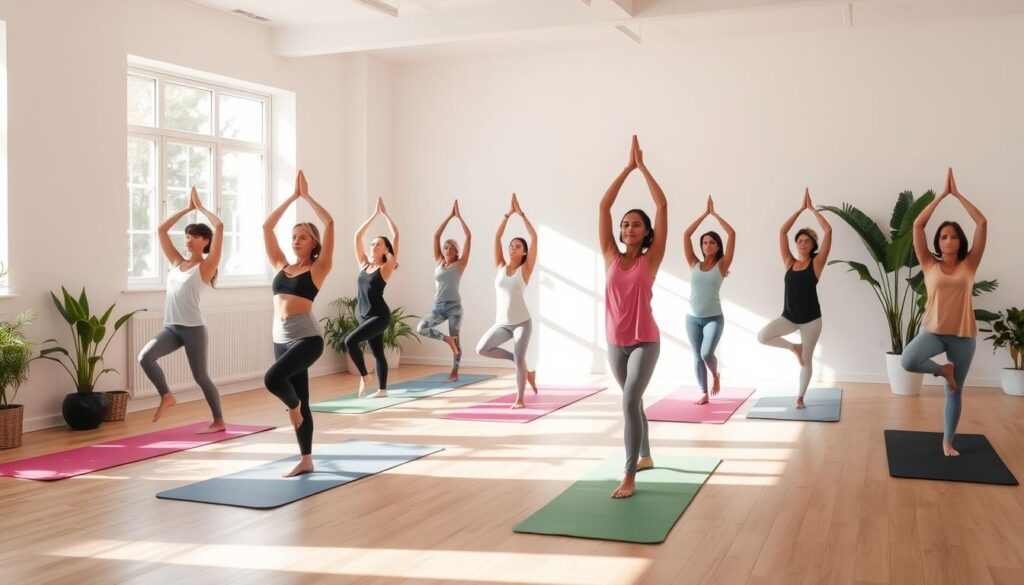
Are you ready to change your fitness journey with yoga? Learning yoga is easier than you think. You don’t need to be super flexible or have years of training. Just be open-minded and ready to learn.
Yoga for beginners at home is now easier than ever. If you want to reduce stress, get stronger, or find a new way to connect with yourself, these yoga basics are for you. This guide will make complex yoga movements simple and easy to follow.
Each pose in this sequence is chosen to teach you the basics. They help you build confidence and lay a strong foundation for your yoga journey. You’ll learn yoga through gentle, supportive movements that fit your current fitness level and body.
Some articles on this site contain affiliate links, which means I may earn a small commission at no extra cost to you if you make a purchase through these links. Additionally, some images on this site are AI-generated for illustrative purposes.
Thank you for supporting my content!
Key Takeaways
- Yoga is adaptable for all fitness levels
- No prior experience is required to start practicing
- Breath and mindfulness are crucial components
- Consistent practice leads to physical and mental benefits
- Start with basic poses and progress gradually
- Listen to your body and modify it as needed
Understanding Yoga: Benefits for Mind and Body
Yoga is more than just a workout. It’s a way to improve both body and mind. It offers many benefits for everyone, no matter their skill level. Yoga combines physical poses, breathing, and meditation for total wellness.
Yoga is special because it does more than just keep you fit. It changes you in deep ways. Let’s look at why yoga is so powerful for personal growth.
Be sure to check out our yoga planner to help you get started on your journey!
Physical Benefits of Regular Practice
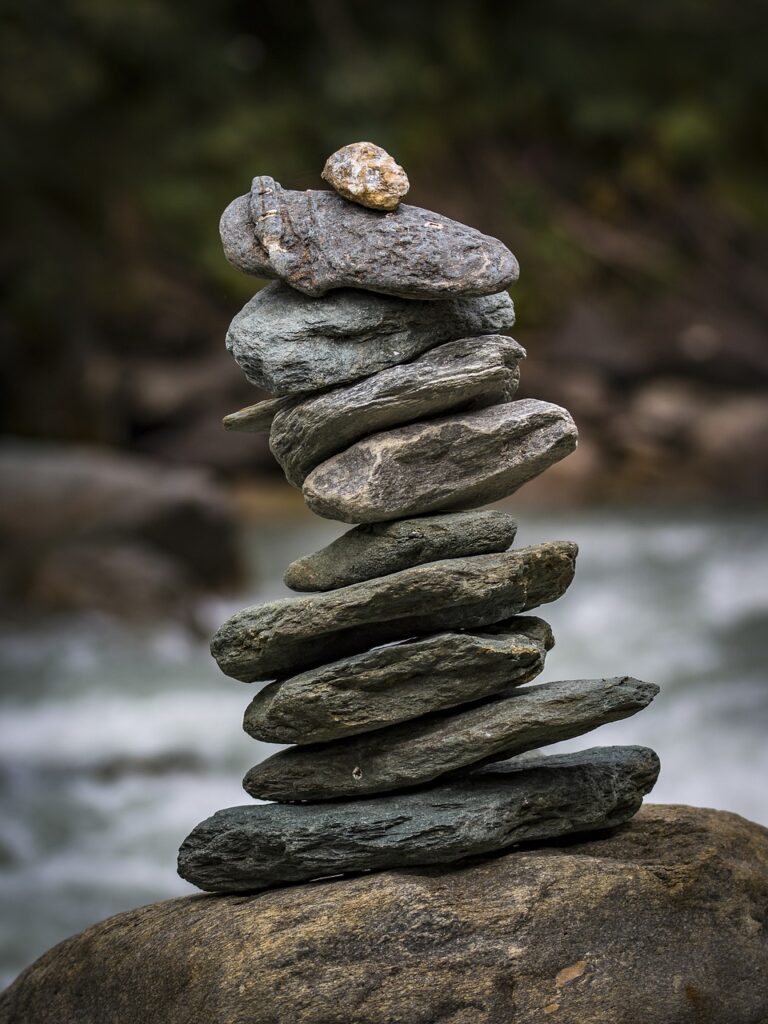
Yoga makes you stronger and more flexible. It’s a workout that’s different from others. People who practice yoga often see big improvements in:
- Muscle tone and core strength
- Increased flexibility and range of motion
- Enhanced body alignment and posture
- Improved balance and coordination
“Yoga is not about touching your toes, it’s about what you learn on the way down.” – Jigar Gor
Mental and Emotional Advantages
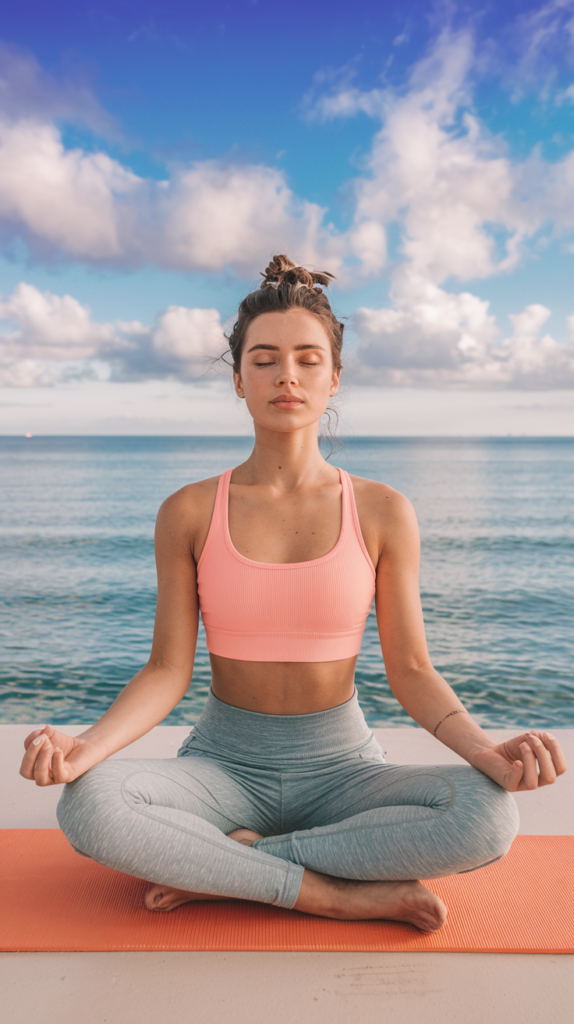
Yoga also helps your mind and emotions. It teaches you to handle stress better. Beginners get benefits like:
- Reduced anxiety and depression
- Enhanced emotional regulation
- Improved concentration and mental clarity
- Better sleep quality
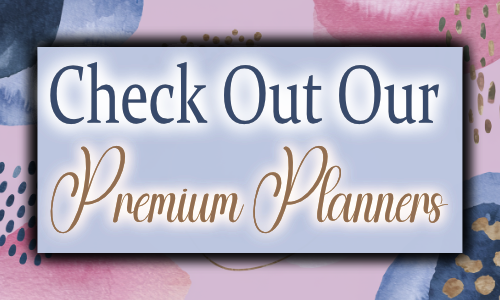
Spiritual Connection and Mindfulness
Yoga also helps you grow spiritually. It makes you more aware of yourself and brings peace. The meditation in yoga teaches you to be present and calm.
Yoga is great for fitness, mental health, or spiritual growth. It’s a complete way to improve your life, fitting your needs and goals.
Getting Started with Yoga, 10 Basic Poses for Your First Practice

Starting your yoga journey is exciting. You’ll learn simple poses that are the base of your practice. These poses help beginners get stronger, more flexible, and more mindful. They’re easy on the body and mind.
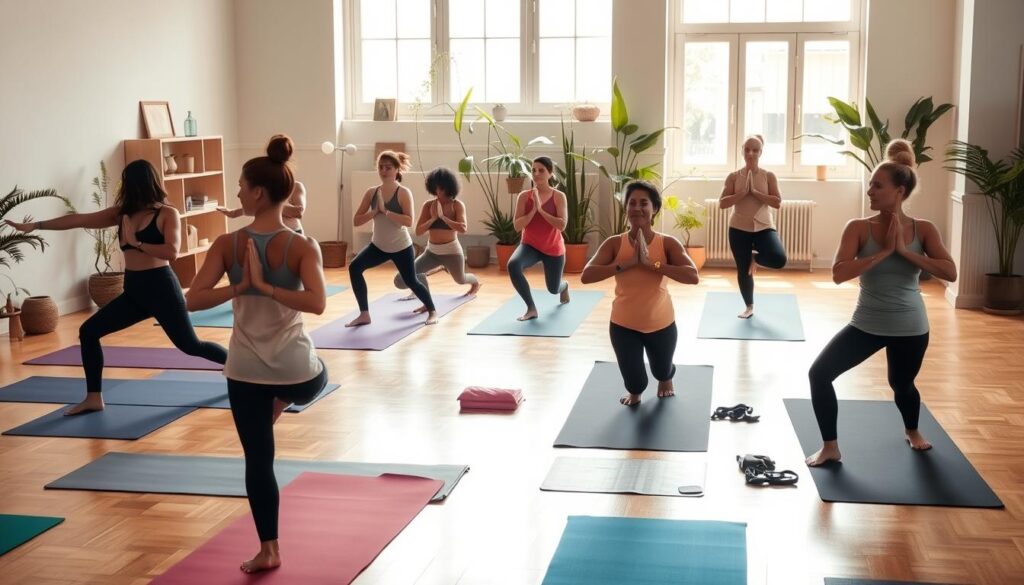
Beginners’ yoga tutorials focus on poses for all fitness levels. Here are 10 basic poses to kickstart your yoga:
- Mountain Pose (Tadasana) – Sets up a good standing posture
- Child’s Pose (Balasana) – A great pose to rest
- Downward Facing Dog (Adho Mukha Svanasana) – Stretches the whole body
- Warrior I (Virabhadrasana I) – Strengthens legs and improves balance
- Tree Pose (Vrksasana) – Boosts balance and focus
- Cat-Cow Stretch (Marjaryasana-Bitilasana) – Makes the spine flexible
- Corpse Pose (Savasana) – Best for relaxation and meditation
- Cobra Pose (Bhujangasana) – Strengthens the back
- Seated Forward Bend (Paschimottanasana) – Stretches hamstrings
- Bridge Pose (Setu Bandhasana) – Opens the chest and strengthens the core
“Yoga is not about touching your toes, it’s about what you learn on the way down.” – Jigar Gor
When doing these poses, listen to your body and move slowly. Each pose has its own benefits for your body and mind. Start with gentle movements and grow your practice as you get more comfortable.
Beginners should focus on proper alignment and breathing. It’s not about perfect poses. Your yoga journey is personal and should be done with patience and kindness to yourself.
Essential Equipment and Creating Your Practice Space

Starting yoga at home needs careful planning and the right tools. The right gear makes your home yoga class comfy and effective. First, learn about the key tools for your practice.
Choosing the Right Yoga Mat
Your yoga mat is the base of your practice. When picking a mat, think about these important points:
- Thickness: Aim for 4-6mm for balanced cushioning
- Material: Look for eco-friendly options like natural rubber
- Texture: Choose a grip that prevents slipping during poses
- Size: Ensure the mat fits you well
“The right mat can make your yoga practice feel like a sanctuary.” – Yoga Wellness Expert
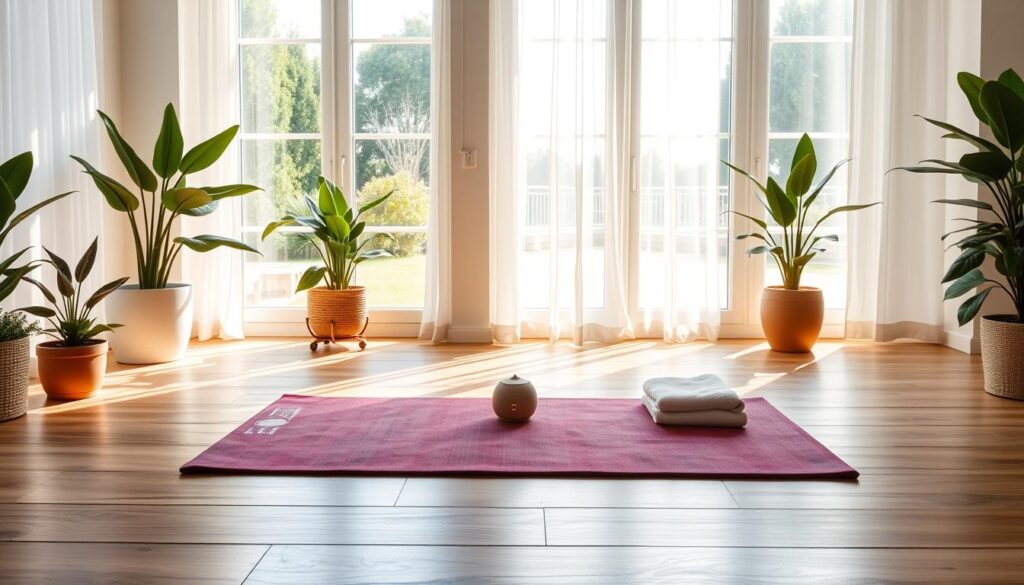
Additional Props for Beginners
Use supportive props to help with alignment and support:
- Yoga blocks for balance and extension
- Comfortable yoga strap for stretching
- Soft blanket for meditation and relaxation
- Bolster for restorative poses
Setting Up Your Home Practice Area
Make a special space for yoga that feels calm and focused. Pick a quiet spot with natural light and room to move. A clean space helps a lot with your yoga.
Pro tip: Keep your practice space clean, peaceful, and inviting to maintain motivation and consistency.
Proper Breathing Techniques and Alignment Basics
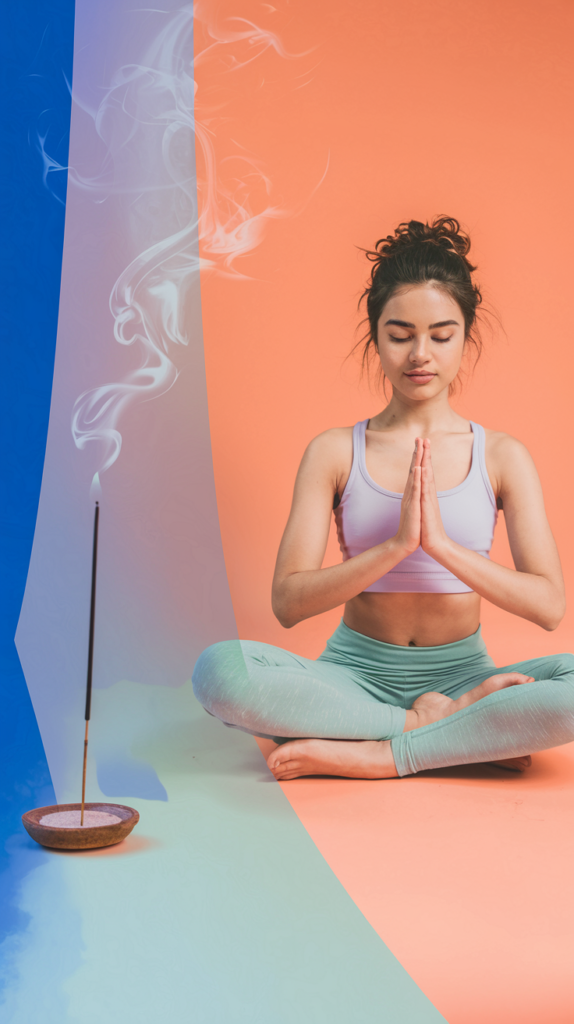
Learning yoga breathing techniques is key to a strong practice. Breath connects your mind and body, linking movement with inner awareness. It helps you focus on your body’s alignment and feel more connected.
“Breath is the anchor that grounds your yoga practice, creating harmony between movement and stillness.” – Yoga Master
Ujjayi, or “ocean breath,” is a basic yoga technique. It involves:
- Slightly constricting the back of the throat
- Creating a soft whispering sound during inhalation and exhalation
- Maintaining a steady, rhythmic breathing pattern
To understand yoga, you need to breathe and position your body right. Important alignment tips include:
- Maintaining a neutral spine
- Engaging core muscles
- Distributing weight evenly
- Keeping joints soft and aligned
Breath awareness helps you understand your body better and move mindfully. By focusing on breathing and alignment, yoga becomes more than exercise. It’s a way to connect your mind, body, and spirit.
Mountain Pose and Standing Postures Foundation
Learning yoga starts with Mountain Pose (Tadasana). It might seem easy, but it’s key to strength, balance, and awareness.

Standing posture is more than just standing. It’s about alignment, awareness, and body positioning. It prepares you for more advanced yoga.
Proper Foot Placement
Yoga for beginners starts with grounding yourself. Your foot placement is key for stability:
- Stand with feet hip-width apart
- Distribute weight evenly across both feet
- Engage the inner arches of your feet
- Press down through all four corners of each foot
Body Alignment Principles
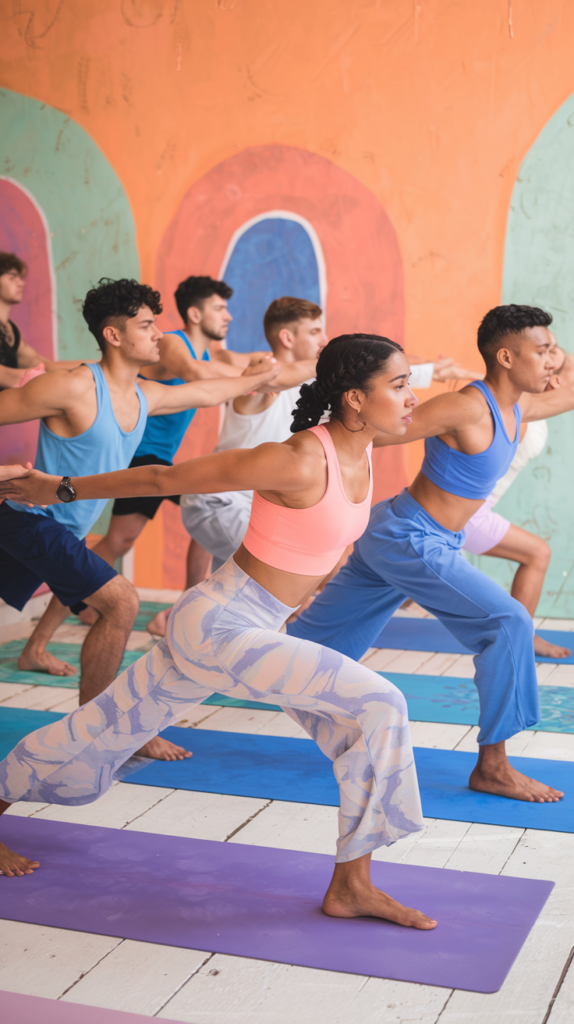
Good alignment makes a basic stance powerful. Focus on these:
- Stack your joints vertically
- Keep your spine neutral and elongated
- Relax your shoulders away from your ears
- Engage your core muscles gently
Common Alignment Mistakes
Beginners often make small but big mistakes. Watch out for these:
- Locking your knees
- Shifting weight unevenly
- Tensing unnecessary muscle groups
- Losing connection with breath
“In Mountain Pose, you are not just standing – you are creating a powerful, grounded connection between earth and body.” – Yoga Alignment Expert
Practice these yoga basics often. They will help you build a strong, mindful base for your yoga journey.
Seated Poses for Building Flexibility
Yoga stretches for beginners can change your flexibility journey. Seated poses are a great start. They help improve your range of motion and wellness.

Seated poses are a basic way to start yoga for flexibility. They let you explore your limits safely. You can keep proper alignment and breathe well.
- Easy Pose (Sukhasana): Ideal for meditation and gentle stretching
- Seated Forward Bend (Paschimottanasana): Targets hamstrings and lower back
- Butterfly Pose (Baddha Konasana): Opens hips and inner thighs
“Flexibility is not about touching your toes, but what you learn on the way down.” – Unknown Yoga Instructor
When practicing these poses, remember to:
- Listen to your body
- Breathe deeply and consistently
- Use props if needed for support
| Pose | Primary Benefits | Duration |
|---|---|---|
| Easy Pose | Improves posture, calms mind | 3-5 minutes |
| Seated Forward Bend | Increases spine and hamstring flexibility | 1-3 minutes |
| Butterfly Pose | Opens hip joints, reduces stress | 2-4 minutes |
Patience is key in developing flexibility. Start slowly and progress gradually to avoid injury and build sustainable practice.
Gentle Twists and Core Strengthening Movements
Core strength is key in yoga. It’s not just about building muscle. It’s about connecting body and mind. Beginners can start with gentle movements to strengthen their core and improve balance.
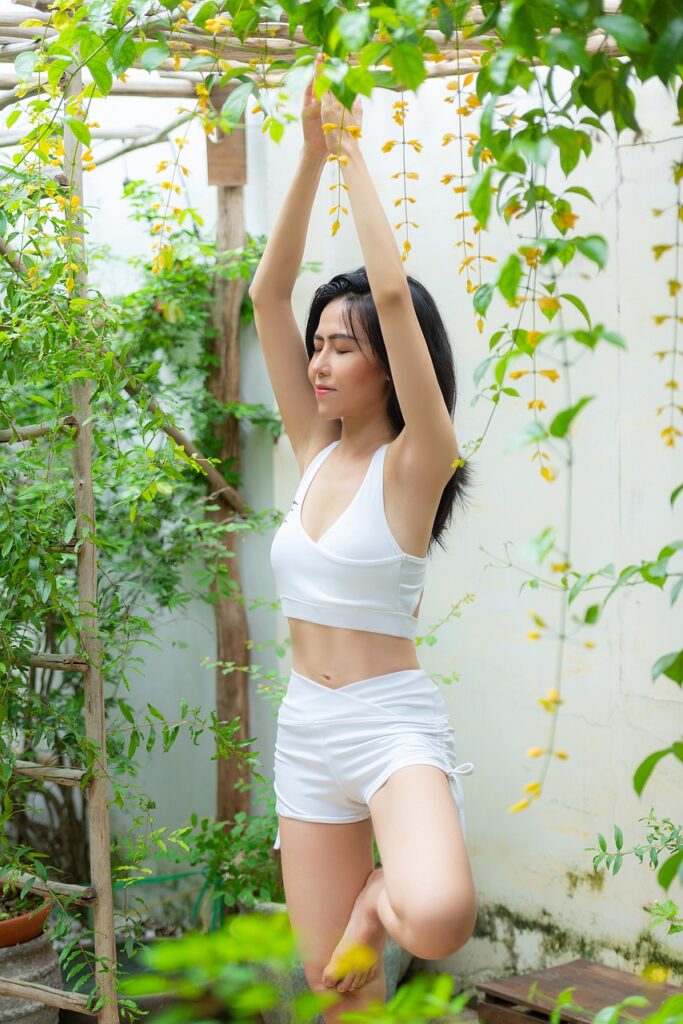
Adding core work to your yoga routine helps prevent injuries. It also prepares you for more challenging poses. Beginner modifications to yoga make these exercises easy for everyone.
Safe Twisting Techniques
Twisting poses are great for the spine and core. Here are some tips:
- Move slowly and with purpose
- Breathe deeply during the twist
- Keep your spine long
- Avoid forcing the twist
Core Engagement Basics
Good core work in yoga is more than just abs. Focus on building a supportive center that ties your whole body together. Start with these yoga poses to engage your core:
- Plank pose
- Boat pose
- Cat-cow stretch
- Bicycle crunches
Modifying for Your Body
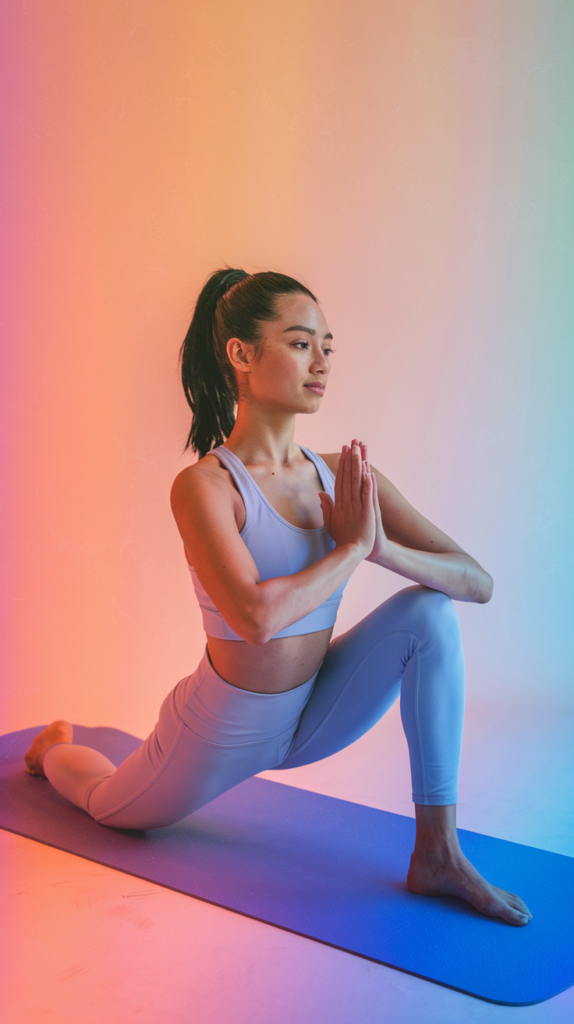
Yoga fits everyone differently. Use props like blocks or straps to help. Listen to your body and adjust as needed.
“Yoga is not about touching your toes. It’s about what you learn on the way down.” – Jigar Gor
Yoga progress comes from regular, mindful practice. Don’t push yourself into poses that feel wrong.
Relaxation Poses for Practice Completion
As you near the end of your yoga, relaxation poses are key. They help your body and mind soak up the practice’s benefits. These moments lead to deep calm.
The top relaxation pose is Savasana (Corpse Pose). It looks simple but is hard for beginners to master.
“Relaxation is the art of letting go – both physically and mentally.” – Yoga Master
- Savasana resets your nervous system
- It helps muscles recover deeply
- Lessens stress and anxiety
- Makes your practice’s benefits last
To do Savasana right, lie flat on your back. Arms should be a bit away. Close your eyes and breathe slowly.
Let each muscle relax, starting with your toes and going up to your head.
Balasana (Child’s Pose) is another gentle pose. It eases back and shoulder tension. It brings peace and surrender.
Relaxation poses are about being, not doing. They are the heart of yoga, where movement turns to stillness.
Creating Your First 20-Minute Sequence
Starting a beginner yoga sequence can seem tough. But, with the right steps, you’ll make a morning routine that wakes you up and centers you. A good yoga class at home needs careful planning. You must know how poses work together.
A 20-minute practice has three parts: warm-up, main practice, and cool-down. Each part is important for getting your body and mind ready for yoga.
Warm-up Sequence
Begin your morning with gentle moves to wake up your body:
- Cat-Cow stretches to warm the spine
- Gentle neck rolls
- Seated side stretches
- Child’s pose for relaxation
Main Practice Flow
The heart of your sequence should have basic poses. They help build strength and flexibility:
- Mountain Pose
- Standing Forward Bend
- Warrior I and II
- Triangle Pose
Cool-down Routine
Finish with poses that help your body relax after yoga:
- Seated forward bend
- Supine twist
- Final relaxation (Savasana)
“A perfect yoga sequence is less about perfection and more about connection with your body.” – Yoga Master
Remember, your first yoga sequence is a personal journey. Listen to your body and modify it as needed.
Conclusion
Starting yoga is a journey of self-discovery and wellness. This guide has shown you the basics to start strong. It’s not about being perfect but about moving and breathing mindfully.
Yoga does more than make you flexible. It teaches patience, self-awareness, and strength. Remember, every yogi was once a beginner, learning and growing with curiosity.
Your yoga path is special to you. Some days will be easy, others hard. See each day as a chance to grow. Stay true to your practice, listen to your body, and be open-minded.
Keep going on your yoga journey, trusting your pace. Small steps lead to big changes. Your mat is a place of discovery, healing, and power. Welcome to the world of yoga!
Be sure to check out our yoga planner to help you get started on your journey!






